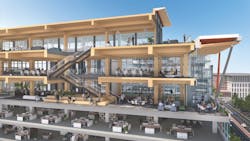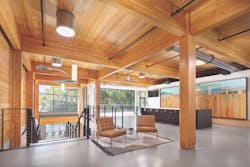Mass timber construction grows up
Anyone who doubts that mass timber is mainstreaming into commercial, institutional, and multifamily construction should direct their gaze toward Arkansas. That’s where Walmart, the world’s largest retailer, was instrumental in luring Structurlam, one of the largest mass timber producers in North America, to open its first U.S. plant in a former Nucor steel factory in Conway, Ark.
One-third of the mass timber that Structurlam produces at the 288,000-sf Conway plant—which opens in mid-2021 and will use Arkansas-grown trees to make cross-laminated timber (CLT) components—is earmarked for Walmart, which already has committed to 1.1 million cubic feet of mass timber for its new corporate headquarters in Bentonville.
Conway will also be Structurlam’s launch pad for expanding in the U.S., where it has sales offices in Portland, Ore., Sacramento, Calif., and Austin, Texas, and intends to open offices in Atlanta, Dallas, and Nashville, Tenn., according to its CEO Hardy Wentzel.
A few months before Walmart and Structurlam announced the Conway plant in early December, the University of Arkansas opened Adohi Hall, a 202,000-sf, 708-bed residence hall made from mass timber and designed by Leers Weinzapfel Associates in collaboration with Mackey Mitchell Architects, OLIN, and local Arkansas firm Modus Studio. Nabholz was the GC on this $79 million project.
Arkansas isn’t the only place where mass timber is making its mark. Last November, First United Bank opened a Gensler-designed 8,500-sf branch in Fredericksburg, Texas, the first mass timber structure in the state, and the first in the world to be built with CLT panels made from Southern Yellow Pine. The bank also completed a 12,500-sf branch in Shawnee, Okla., the first of its kind in that state, and will complete a 37,000-sf project in Sherman, Texas, in 2020. “These three projects reflect First United’s commitment to sustainable choices,” says Melissa Perrin, First United’s Senior Vice President of Culture.
In San Francisco, Brookfield Properties and Hacker Architects in December unveiled the designs for what would be the largest mass timber office building in North America, a 310,000-sf, 85-foot-tall structure that’s part of Brookfield’s 28-acre Pier 70 waterfront development.
These and myriad other mass timber projects in the works are remarkable for the fact that, until 2011, there were no CLT factories in the U.S.; components had to be imported from Canada or Europe, the latter where mass timber has been a construction material since the 1990s. And it wasn’t until 2015 that CLT was incorporated into the National Design Specification for wood construction, which led to it being recognized as a building product in the 2015 International Building Code (IBC).
Mass timber in the building codes
Mass timber is likely to get an even bigger boost from the 2021 IBC that will include three new construction types allowing for the use of CLT in buildings up to 18 stories tall.
Mass timber’s ascent to acceptability in North America is attributable to two dynamics: advances in manufacturing technology and increased supply, says Gerald Epp, Jr., EIT, Business Development Engineer with British Columbia-based StructureCraft Builders, a 20-year-old engineering and construction firm that makes dowel-connected floor and roof panels at its 41,000-sf shop.
The tipping point occurred five years ago, when StructureCraft was part of the building team for T3, the 180,000-sf office building in Minneapolis that, when it was completed in 2016, catalyzed greater interest in mass timber among U.S. developers and their AEC partners. (Hines developed the T3 project.)
What makes mass timber attractive is that it’s a renewable resource at a time when more developers are focused on reducing their buildings’ carbon footprint. The components are also faster to build with, resist fire better than conventional wood, and are resilient during seismic events.
“Mass timber promises simplification: speedier construction with a multipurpose material, greater insulating capacity, thermal mass, a vapor barrier, and less construction waste,” says Oliver Schaper, LEED AP BD+C, CDT, Design Director and Principal with Gensler.
What separates mass timber from lumber and heavy-timber construction is “the use of technology for precision manufacturing of components that can be customized using 3D modeling and CNC machines,” says Erica Spiritos, Preconstruction Manager with Swinerton Mass Timber, which Swinerton launched in November 2018.
A number of firms, like Lendlease, have been among the vanguard building with mass timber. Perkins and Will has specified mass timber on around 20 projects, including CLT roofing for the expansion of Montreal’s REM Train System, CLT floor panels for the Girl Scout cabins and dining hall at Camp Lakota in greater Los Angeles, and the Southwest Library in Washington, D.C., which is in fabrication. “Clients are seeking us out,” says Andrew Tsay Jacobs, AIA, EIT, LEED AP, Associate Project Architect and Director of Perkins and Will’s Building Technology Lab. With the exception of hospitals, Tsay doesn’t see any impediments to using mass timber for most buildings.
A value play for some building owners
Mass timber’s appeal extends to design aesthetics that other materials don’t offer to developers looking for a fresh marketing angle to attract tenants.
In Washington, D.C., Arup and architect Hickok Cole are designing 80 M Street SE for Columbia Property Trust, a 100,000-sf mass timber vertical extension to an existing seven-story building. Construction is scheduled to begin in 2021. The overbuild will add two floors of office space with 17-foot-high ceilings.
The D.C. market is glutted with office space, and Columbia believes that using mass timber could be a differentiator for quicker leasing and higher rents, says Lauren Wingo, Arup’s Senior Structural Engineer.
Tom Corrado, an architect and mass timber expert with Hickok Cole, notes that “D.C. is a concrete town,” so other building systems are weighed for cost. “The question is whether we can provide wood that allows our clients to get more value for their finished product. It’s a value-added play here,” says Corrado.
That same calculus was at work in San Antonio, where StructureCraft provided structural engineering and construction services for The Soto, a 120,000-sf six-story office building that is the city’s first mass timber project. The developer, Hixon Properties, “wanted to offer something different to the market,” says Epp. (Lake|Flato and BOKA Powell were the architects; Byrne Construction the GC.)
It doesn’t hurt, either, that mass timber saves money by reducing construction times. Brookfield Properties estimates that Pier 70’s mass timber office building might be completed four to six months faster than it would with concrete or steel. Corrado says the overbuild at 80 M Street will take eight weeks to construct, versus “several months” were it built with other materials.
“Every project we start now, we have a discussion with the client about mass timber,” says Corrado. “We believe in the system.”
Last August, DPR Construction moved into new offices in Sacramento, Calif., an adaptive-reuse project for which it deployed glue-laminated beams (glulam) and CLT for a 6,000-sf addition that went up in only six days, says Marshall Andrews, DPR Construction’s Project Manager. Mass timber “allows for aesthetic choices, prefab and self-perform opportunities, and sustainability” because of its lower embodied carbon, according to Andrews.
Andrews and other AEC sources point out that because mass timber is factory produced, it requires more preplanning than other materials. For the Sacramento project, DPR did a lot of BIM coordination with the factory to determine all of the structural connections, the sprinkler system installation, and where 22 tubular daylight devices would be placed.
CLT suppliers scramble
Given the sheer amount of vertical infrastructure that will be needed worldwide over the next generation, no single building material is likely to dominate. Even now, some industry watchers wonder if mass timber producers can keep up with current demand.
When BD+C interviewed Swinerton’s Spiritos in early December, she pointed to “bottlenecks” in glulam fabrication, as only three of the six glulam machines in the U.S. can fabricate components large enough for commercial construction. Jacobs says Perkins and Will “settled” for mass plywood on a recent project because the amount of CLT it needed wasn’t available.
Three companies—Katerra, Vaagen Timbers, and SmartLam—brought plants online in 2019 that, says Spiritos, doubled the CLT production capacity in the U.S. SmartLam also reorganized to expand its presence throughout North America. It already operates plants in Montana and Alabama, and plans to open three more by 2022, which would boost its annual CLT production capacity to more than 17.2 million cubic feet.
As supply increases, the next question will be to what extent cities embrace mass timber.
ALSO SEE: A new report predicts significant demand growth for mass timber components
“Fire marshals and code officers are driving these decisions, and their willingness to approve mass timber varies by municipality,” observes Rives Taylor, FAIA, LEED BD+C, Principal and Firmwide Co-director of Design Resilience with Gensler. Taylor thinks the 2021 IBC could agitate a “fundamental shift” in how the industry views mass timber.
“It will be easier for jurisdictions to adopt it and rely on the expertise of others,” says DPR’s Andrews. Spiritos foresees the new codes ushering in a “prescriptive pathway” for mass timber construction, especially for eight- to 12-story residential projects.
There are about 70 tall wood building projects in the works (half of them east of the Mississippi River) ready to move forward once the new codes kick in, says Bill Parsons, PE, Vice President of Operations for WoodWorks, the education and technical support arm of the Wood Products Council.
What’s needed next, he asserts, is instruction about how to use mass timber. WoodWorks has conducted one-day construction management training programs in Virginia and Washington state, the latter of which drew more than 100 contractors. WoodWorks plans to conduct training programs in all major markets.


